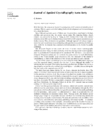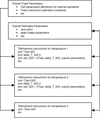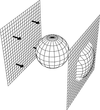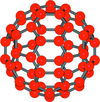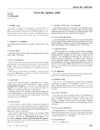issue contents
February 2007 issue

Cover illustration: Molecular electrostatic potential of thymidine mapped on the charge density isosurface at 0.5 e Å-3 using MolIso. Courtesy of C. B. Huebschle & P. Luger [J. Appl. Cryst. (2006), 39, 901-904].
editorial
Free 

research papers
The structural phase transition from aragonite to calcite in biogenic samples extracted en bloc (without pulverization) from the skeletons of two scleractinian corals (Desmophyllum and Favia) was studied by synchrotron radiation diffraction.
Download citation


Download citation


Chain orientation and chain continuity in structural refinement of polymers are discussed. The structure of polyisobutene has been reconsidered, using new X-ray diffraction measurements and performing a structure refinement with the aid of a proprietary computer program, based on revised approaches to the presented arguments.
A simple numerical approach for calculating the q-dependence of the scattering intensity in small-angle X-ray or neutron scattering (SAXS/SANS) is discussed.
Stress-induced broadening of single-crystal reflections together with the measurement of shear wave propagation has been used to determine the effective limits of hydrostatic behaviour in several fluids widely used as pressure media.
Microstructural characterization of ball-milled α-Al2O3 has been performed by X-ray line broadening analysis. The super-Lorentzian profile shapes of the X-ray diffraction pattern have been characterized by bimodal size distribution and shape anisotropy of the milled α-Al2O3 crystallites.
Analytic expressions are developed for the resolution functions of small-angle neutron scattering instruments. Applications, including the optimal design, the analyses of smearing effects as well as data re-binning, to the case of time-of-flight devices with rectangular apertures are presented.
A new solid-solution phase has been identified in the binary paraffin blend xC28H58.(1−x)C36H/D74 for 0.94 ≥ x ≥ 0.65.
The method of basic functions in the contrast variation technique of small-angle scattering is considered for cases of polydisperse and superparamagnetic systems.
Theoretical small-angle X-ray scattering cross sections of modeled latent ion tracks have been derived, enabling the determination of structure parameters of tracks created along wakes of highly energetic heavy ions in dielectric solids.
Structural analysis of metallic liquids and glasses is complicated by the lack of long-range order.
Open  access
access
 access
accessThe use of `parametric Rietveld refinement' to extract information from large numbers of powder diffraction patterns using a single evolving structural model is described.
The orientation distribution or `morphological texture function' of the fibres in a composite material is determined from measurements of the crystallographic texture of the fibres themselves.
Download citation


Download citation


Open  access
access
 access
accessThe structures of the α, β and γ polymorphs of quinacridone were predicted using Polymorph Predictor software in combination with X-ray powder diffraction patterns of limited quality. The present work demonstrates a method to obtain crystal structures of industrially important pigments when only a low-quality powder pattern is available.
Microbeam scanning texture analysis enables the determination of the orientations of the mineral apatite nanocrystals in bone with a positional resolution of 1 µm.
The possibility of performing powder diffraction experiments on proteins under cryocooled conditions has been demonstrated by means of systematic variations of the concentration and type of cryoprotectant agent on chicken egg white lysozyme.
The crystal symmetry and quality of an Er3+–Yb3+ co-doped yttrium calcium oxoborate [Er3+:Yb3+:Ca4YO(BO3)3, abbreviated as Er:Yb:YCOB] crystal, grown by the Czochralski method, were examined using X-ray diffraction. The specific heat, thermal expansion coefficient and thermal conductivity of the as-grown Er:Yb:YCOB crystal were studied systematically using crystal samples with different crystallographic orientations.
Use of 2 Å multiple protein image-plate powder patterns that show solvent-induced or radiation-damage-induced lattice strains gives improved structural results from stereochemically restrained Rietveld refinements.
Dynamic (multiple) diffraction effects were recently shown to play a role in the diffraction of colloidal crystals. A simple model is presented based on the Wentzel–Kramer–Brillouin approximation to allow for dynamic effects.
A method based on the phase-object approximation is used to describe small-angle neutron scattering experiments on silicon gratings.
Download citation


Download citation


Photocrystallography is used to investigate the photoswitching of the compound {[Fe(bt)(NCS)2]2(bpym)}, by combining X-ray diffraction and laser irradiation. The structural investigations demonstrate the strong coupling between the electronic and structural degrees of freedom and the photoselective and reversible switching between different states.
General equations are given for background subtraction of SANS treatment, which account for large scattering angles ( ) and allow the extraction of the scattering due to the sample when the later is inside a container that displays a spurious scattering signal. Several calibration methods to determine the inherent sample backgrounds are also described.
) and allow the extraction of the scattering due to the sample when the later is inside a container that displays a spurious scattering signal. Several calibration methods to determine the inherent sample backgrounds are also described.
computer programs
Open  access
access
 access
accessFibreFix integrates various programs for the analysis of non-crystalline diffraction patterns into a single user-friendly package. The main features of FibreFix are outlined and some of its applications are illustrated.
The Fortran90 sources of the UMWEG-specific subroutines of the program UMWEG are presented and deposited, together with the PostScript-plot software subroutines and the simple and short main program of the command-line version of the program UMWEG.
DRAWxtl is an open-source computer program for crystal structure drawings that can be used with the Windows, Mac OS X and Linux operating systems. Beginning with version 5.3, the program can display aperiodic structures in up to (3+3) dimensions.
laboratory notes
The successful application of single-bounce X-ray focusing capillary small-angle X-ray scattering measurements on proteins, without loss of resolution, is presented.
Open  access
access
 access
accessThe use of a polymeric (Torlon or polyamide–imide) gasket material in a Paris–Edinburgh pressure cell for in situ high-pressure X-ray scattering measurements is demonstrated. The quality of the data obtained in this way is suitable for Bragg and pair distribution function analysis.
A new device for electric-field-induced protein crystallization using the microbatch method has been fabricated and successfully tested.
new commercial products
international union of crystallography
Free 



 journal menu
journal menu








